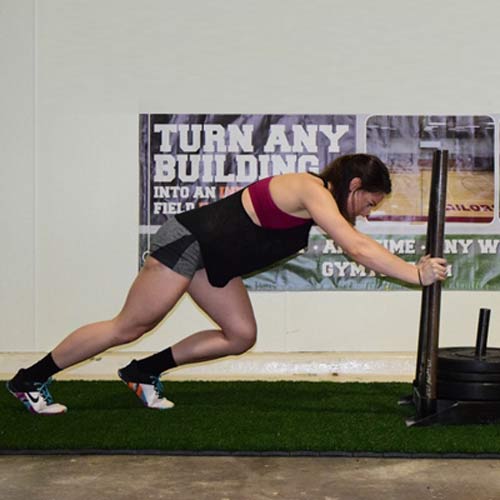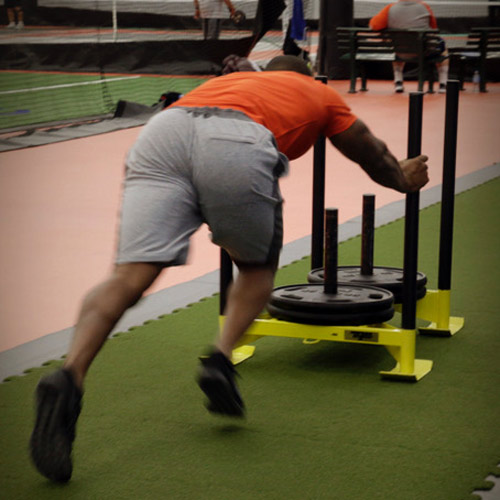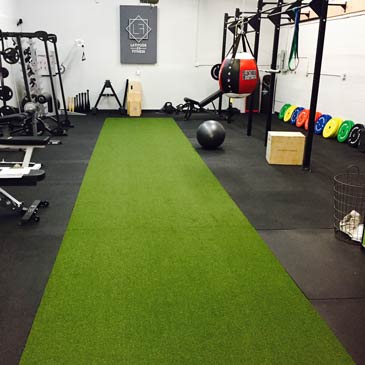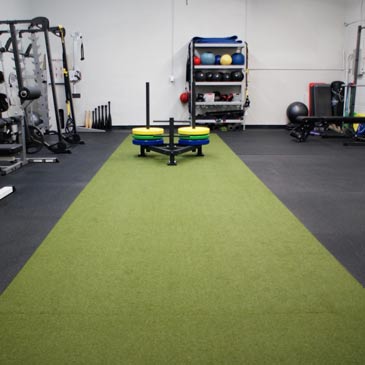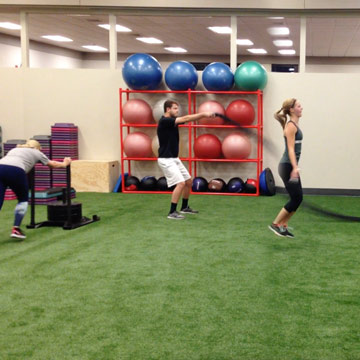Can artificial turf be laid on concrete for sled strips?
Related Product: V-Max Artificial Grass Turf 3/4 Inch x 15 Ft. Wide 5mm Pad Per SF
When using a heavy sled with improper flooring, the sled may snag on the floor. This can cause anything from frustration for the athlete to broken equipment to a serious injury if the athlete has a significant stumble or misstep.
Selecting a high quality of sled strip turf, like the V Max Artificial Grass Turf, is a good start.
The next step is securing the turf to the subfloor, creating a safe and long lasting environment that’s perfect for many workouts, including football, track or CrossFit.
Artificial turf for sled strips can be laid on concrete, but certain steps need to be followed to install the turf safely. For example, if you’re using a CrossFit sled, it needs to be able to slide smoothly along the turf to provide the desired workout results. If the sled track astro turf is not secured to the cement properly, it could bunch up as the sled goes across it, leading to a tripping hazard.
Fortunately, there are a couple of options that make securing the sled strip turf to concrete an easy and safe process.
Securing Small Areas of Turf
When placing smaller pieces of turf on concrete, it’s recommended that the edges of the pieces are glued down. This allows the indoor turf to remain in place, even when placed under stress, such as occurs with a push sled.Prepare the Subfloor
Before using adhesive on the concrete floor in a home gym or a garage, it’s important to prepare the subfloor. Any imperfections in the concrete subfloor could cause the sled strip turf to warp or to match the imperfections. A heavy push sled could become caught on one of these imperfections, causing an issue.
The concrete should be cured, cleaned, and allowed to dry. Patch any cracks and fix any areas that have crumbled. If the cement floor is not level, these depressions should be repaired as well.
Install with Adhesive
When using glue for the roll of turf, all paint, oil, or other old adhesive should be removed from the concrete before applying the new adhesive. You want the glue to adhere properly to the concrete, eliminating the risk of the edge of the sled strip turf pad popping loose under the pressure of a workout.
Finally, if the concrete area where you want to install the sled turf workout area suffers from moisture seepage, a glue down installation may not work. You can obtain a test kit for the concrete floor to see whether its moisture condition is too great to allow the adhesive to adhere properly.
Securing Large Areas of Turf
Install with Hook and Loop ConnectorsWhen you’re mounting a large section of sled strip turf roll to the cement flooring, you can use adhesive, or you can use strips of hook and loop connectors. When you want the ability to remove the turf and return to the subfloor, creating a portable artificial turf option, the hook and loop connectors are the proper choice.
Hook and loop connectors will tightly hold the larger section of turf to the ground, while also allowing you to roll up the turf and return to the concrete later as needed. These connectors have an impressive level of strength, keeping the turf in place when it’s under stress from a push sled.
The Hook and Loop Attachment is the perfect choice to adhere a roll of turf over a large section of cement flooring. Each section of the connector measures 4 inches in width.
You’ll adhere the back of the hook section (with the rough side facing upward) to the cement floor. (Follow the directions we listed earlier to prepare the concrete for the glue.) Place the hook side on the concrete floor in the location where the seams of two pieces of sled strip turf will meet, splitting the 4-inch width, so each piece of turf covers 2 inches of the hook section of the connector.
Setting up the turf this way will keep the seams on the turf from curling. This reduces a tripping hazard, which is especially important for turf where you’ll be using a push sled or holding football practice. If you have a raised or loose seam, the athlete could stumble or trip, creating a dangerous situation.
Next, you’ll attach the back side of the loop section (with the soft side facing outward) to the back of the roll of turf (or the pad side). Each loop side is 2 inches in width. It’s best to sew the loop side to the pad on the back of the sled strip turf, ensuring the section will remain in place. Then press the sections of turf to the floor, connecting the hook section to the loop section.
